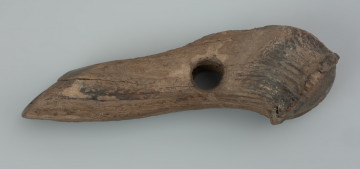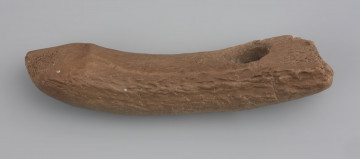
Hoe
9600 p.n.e. — 4100 p.n.e.
National Museum in Szczecin
Part of the collection: Stone Age
The axe holder from red deer antlers was discovered in unknown circumstances in Szczecin, in the Bay of Łęczna on Lake Dąbie in 1943. The object was made from a shed of the left beam. The antlers are relatively weak, which suggests that they came from a very young or, on the contrary, an old and weak male. The first stage in the holder's production was to cut off the beam above the bay antler, from which the spongiosa, the spongy inner part of the antler, was then removed. Thereby, a sleeve was formed to embed flint tools such as a small axe, pike or scraper. Traces of intensive use are preserved on the holder. At the end and in the central part of the sleeve for setting a flint piece, there are visible breaks caused by contact with a hard material (e.g., wood). The shining and smoothing of the surface at the end of the brow tine might result from holding the tool in hand, while those at the base are from carrying it by the belt. Numerous wear marks from use are also visible on the rose. Their presence suggests that the tool may have been used as a hammer. The holder from the Bay of Łęczna has no direct analogues among other finds from northern Europe, although such objects were quite typical of hunter-gatherer communities. It is distinguished by its unusual form, not found anywhere else.
Michał Adamczyk
Author / creator
Dimensions
cały obiekt: height: 22.9 cm, width: 11.8 cm
Object type
mount (fitting)
Technique
cutting, chiseling, breaking, setting, softening
Material
red deer antlers
Origin / acquisition method
acquisition
Creation time / dating
Creation / finding place
Owner
National Museum in Szczecin
Identification number
Location / status

9600 p.n.e. — 4100 p.n.e.
National Museum in Szczecin

7000 p.n.e. — 5400 p.n.e.
National Museum in Szczecin

9600 p.n.e. — 5400 p.n.e.
National Museum in Szczecin
DISCOVER this TOPIC
National Museum in Szczecin
DISCOVER this PATH
Educational path